INVENTIONS MINIMIZING FARM LABOR
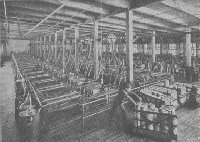 | By courtesy of the McCormick Division
International Harvester Co.
Manufacturing binder twine. |
Farm labor, like everything else, has undergone a great change during the last fifty years. Previous to that time, almost everything was done by hand. The sickle, scythe and cradle have been supplanted by inventions that would make the heads of our forefathers reel with amazement.
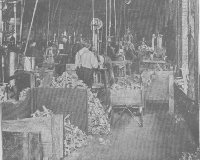 | By courtesy of the McCormick Division
International Harvester Co.
Boring knotter frames. |
The reaper, a machine designed to harvest small grain such as wheat., oats, barley and rye, was invented in 1831 by Cyrus H. McCormick. Prior to that time wheat and other grains were gathered by hand with the cradle, which had superseded the reaping hook. Since its invention the importance of the reaping machine has been recognized by the world. During the years of the early development of the reaper the Hon. Wm. H. Seward said: "It moved the line of civilization westward thirty miles every year."
The first reaping machine built by McCormick in 1831, and operated in the harvest of that year, was the prototype of the harvesting machine industry that has grown to the stupendous proportions which characterize it at the present time. To-day more than 3,000,000 McCormick machines are in use throughout the world. Inasmuch as each machine does the work of ten men, the McCormick machines in use are equivalent to an army of 30,000,000 men. These machines have multiplied the world's production of wheat many times, thus banishing the fear of famine, and making flour so abundant that the best bread is no longer a luxury.
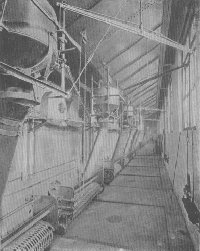 | Automatic feeding of coal in
boiler room,
McCormick Harvesting Machine Co. |
Harvesting machines now embrace binders, reapers, headers, header-binders, rice binders, mowers, hay rakes, corn binders and huskers and shredders. The binder, the most improved type of harvesting machine, will cut and bind 15 acres of wheat in a day of ten hours. The machine requires only one man to operate it, while the work it does is equivalent to the work of ten able bodied men. Moreover, the work done by the machine is in every way superior to that done by hand.
SHREDDING CORN.
The introduction of the husker and shredder has greatly assisted the farmer in handling the corn crop. The machine husks the corn and shreds the fodder, leaves and husks into feed that is worth as much as timothy hay. By handling the corn crop with machines, the corn grower saves all of his crop—the ears as well as the stalks—thus practically doubling the value of the corn crop, inasmuch as the stalks in former years have gone to waste in the field.
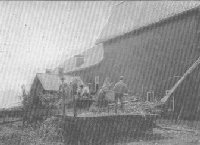 | By courtesy of the McCormick Division
International Harvester Co.
Shredding corn. |
Chemical analysis has shown that nearly half the feeding value of the corn crop is in the fodder. This makes the hitherto neglected fodder crop the second most valuable one produced in America—worth more than wheat, oats, cotton, hay, or any other crop, excepting the corn itself. The McCormick husker and shredder has made it possible to prepare the fodder at a minimum expense, so that practically the entire stalk is eaten by horses as well as cattle, and do well on it. Some of the statements made by practical dairymen, who have been feeding shredded fodder for years, seem almost incredible.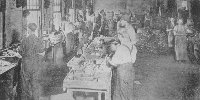 | By courtesy of the McCormick Division
International Harvester Co.
Making knoter hooks and
binder needles. |
They say that as a milk producer it is far superior to timothy hay, and many maintain that it is better than clover, if fed with a well considered ration of grain to supply the protein, in which fodder is somewhat deficient. Many of the leading dairy and stock men no longer grow hay, plowing up their meadows not needed for pasture and using shredded fodder as their sole forage crop, which enables them to make a large increase in their output of beef and butter.
THE SEWING MACHINE AND KNITTING MACHINE
DRIVING MECHANISM OF THE HORSELESS VEHICLE
Table of Contents
Return to Main Page
© 1998, 2002 by Lynn Waterman
|




